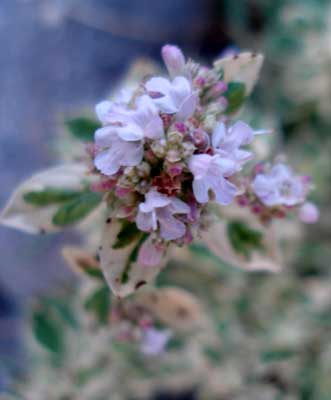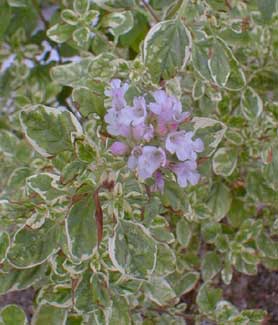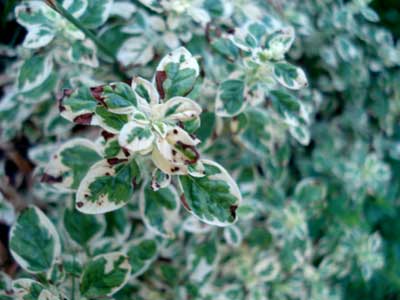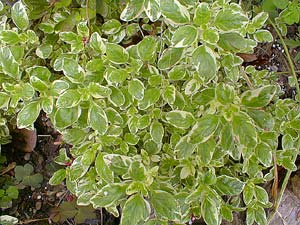
Tricolored Dwarf Marjoram
aka, Variegated Wild Greek Oregano
"And bury me in Saint Mary's church,
All for my love so true,
And make me a garland of marjoram,
And of lemon-thyme, & rue."
-traditional ballad
 Oregano has been used as a folk remedy for sundry ailments, including diabetes, arthritis, hemophelia, or to control spasms, among other things largely unsubstantiated, though a few decent studies have had promising intimations of efficacy treating fungal infection & even such serious illness as leukemia.
Oregano has been used as a folk remedy for sundry ailments, including diabetes, arthritis, hemophelia, or to control spasms, among other things largely unsubstantiated, though a few decent studies have had promising intimations of efficacy treating fungal infection & even such serious illness as leukemia.Although its medicinal value is in most situations suspect or debatable, it does have a high measure of antioxidant chemical components, has a definitely positive effect on digestion & respiratory function, & is as good as anything else (meaning not that good) for the common cold & soar throat, having even a sedative effect taken in large enough quantity.
Its toxic potential is nearly zero, except to the rare individual allergic to oregano, or if taken in large concentrated amounts which can induce abortions. Essential oils from oregeno are used for topical pain relief including toothache. Its high thymol content makes these oils one of the best natural anteseptics.
 Variegated Dwarf Greek oregano, or TriColor Marjoram (Origanum vulgare 'Variegata'), grows to about a five inch height, slowly spreading into a solid groundcover just dense enough to suppress weeds.
Variegated Dwarf Greek oregano, or TriColor Marjoram (Origanum vulgare 'Variegata'), grows to about a five inch height, slowly spreading into a solid groundcover just dense enough to suppress weeds.It likes full sun to partial shade & is cold hardy to minus thirty. It's not as frost-tender as many other oreganos, & is nearly evergreen through winter, though it does get unsightly toward the end of our mild Zone 8 winters. It will likely die to the ground in colder areas, but leap back to life in spring.
Although variegated plants tend to be at least a tiny bit more delicate than non-variegated, in this case the TriColor has seemed to be a smidgen hardier than the regular O. vulgar 'Humile' dwarf marjoram which we have growing alongside the TriColor. Both, of course, are very hardy.
TriColor Marjoram has a low water requirement; its drought tolerance is much higher than for most xeric garden perennials. A July photo (third on this page) was taken in the midst of a record-breaking heatwave with weeks without rainfall, & the marjoram at the far rim of our property was rarely if ever watered. Yet in that photo you'll see only the slightest sunburn which it wouldn't've experienced at all if there'd been at least a couple waterings.
 It prefers acid-neutral to slightly alkaline soil, but adapts to our region's richer acidic soils. Indeed, it can adapt to conditions that are dry or moist, with rich or poor soil, & even does well in coastal gardens that experience salt mist, or high winds.
It prefers acid-neutral to slightly alkaline soil, but adapts to our region's richer acidic soils. Indeed, it can adapt to conditions that are dry or moist, with rich or poor soil, & even does well in coastal gardens that experience salt mist, or high winds.White to pale pink, heremaphraditic flowers appear July through September. They're pollinated by bees, moths, & butterflies. It self-seeds August through October. Even when not in flower, the TriColor variety is gorgeous just for its leaves of gold, green & cream.
Marjoram is believed by many to repel ants & is sometimes grown at the fringe of a vegetable garden to discourage unwanted insects. The species is a basic herb in Mediterranean cookery, & can also be used in herb tea.
Of the several oreganos we grow this one isn't my favorite for flavor, & the leaves are so tiny it's not easy to keep the leaf to stem ratio low on the stem side. The variety I am instead constantly trimming for kitchen use is the mild & flavorful O. vulgare 'Dr. Ietswaart' Golden Oregano.